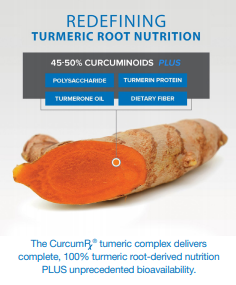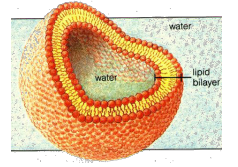Turmeric is derived from Curcuma longa rhizomes.
Most of the interest in turmeric has been focused on its
curcuminoids, primarily curcumin, as it is the principal
curcuminoid (exists in the highest concentration)
and to a lesser degree bisdemethoxycurcumin and
demethoxycurcumin. While curcumin is thought to be
the most bioactive compound found in turmeric, turmeric
actually contains/provides more that 200 compounds of
nutritional interest. They include additional curcuminoids
such as atlantone, diarylheptanoids and turmerone,
and numerous other bioactive compounds such as
monoterpenes, sesquiterpenes, diterpenes, triterpenoids,
alkaloids, sterols, fatty acids, and so on.1
Under standard circumstance, absorption of orally
ingested curcuminoid extracts is poor. Therefore,
companies have been working hard to develop methods
to enhance their bioavailability, with some success.
Even so, they limit their offerings to a limited group of
curcuminoids.
offers a truly transformational product
supplying an all-natural turmeric complex, providing an
unprecedented range of beneficial turmeric root nutrients,
with 5– 6 times greater bioavailability versus other
professional brands.
CurcumRx supplies a nutrient dense turmeric complex
delivering 50% total curcuminoid content, plus turmeric’s
other naturally occurring compounds, including phenolic
compounds, sesquiterpenes, sterols, fatty acids, and more!
 CurcuminRx utilizes a specialized processing technology
CurcuminRx utilizes a specialized processing technologyresulting in a dual phase polar/non-polar emulsion,
concentrating turmeric’s many nutrients, and enhancing
the bioavailability without the use of nanotechnology,
including the use of “tweens” and other surfactants that
may damage lipid membranes and result in leaky gut.
Numerous studies, including human and animal in-vivo
studies,have reported on the antioxidant effects of
tumeric compounds. Turmeric preparations have been found to scavenge peroxides and phenolic oxidants, and
inhibit lipid peroxidation induced by chemical agents.
Curcumin antioxidant properties are noted by its action
as a scavenger of both reactive oxygen species and
reactive nitrogen species. In-vitro research demonstrates
the prevention of oxidative damage to DNA. 2
Its use has been correlated to the protection of endothelial
cells against oxidative stress.3
Other research suggests turmeric compounds other than®
curcumin contribute antioxidant activity.4
Turmeric and its curcuminoid constituents have been
found to inhibit lipoxygenase and cyclooxygenase
in-vitro. 5,6,7
Results of an animal study indicates that oral
administration of curcumin may reduce expression of
several cytokines, chemokines, and proteinases known to
mediate aneurysmal degeneration, and it has been shown
to be an effective inhibitor to the activation and release
of NF-kB.8,9 In-vitro results suggest that curcumin most
likely inhibits cell proliferation, cell mediated cytotoxicity,
and cytokine production by inhibiting NF-kB target gene
involved in induction of these immune responses.10 It
was concluded that curcumin has antioxidant activity
and inhibits inflammatory mediators, including NF-kB,
cyclooxygenase-2 (COX-2), lipoxygenase (LOX), and
inducible nitric oxide synthase (iNOS). 10,11
References 1. Medicinal Plants-Recent Advances in Research and Development. Editors: Tsay,
Shyur, Agrawal, Wu, Wang. Springer Science-Business Media Singapore ©2016
2. Shalini, V K and Srinivas L. Lipid peroxide induced DNA damage protection by
turmeric (Curcuma longa), Mol Cell Biochem 1987; 77(1):3-10.
3. Motterlini R, et al. Curcumin, an antioxidant and anti-inflammatory agent, induces
heme oxygenase-1 and protects endothelial cells against oxidative stress. Free
Radical Biology and Medicine. 2000 28: 1303-1312.
4. Srinivas, l and Shalini, VK. DNA damage by smoke: protection by turmeric and
other inhibitors of ROS. Free Radical Biol Med 1991; 11(3): 277-283.
5. Flynn DL, Rafferty MF and Boctor AM. Inhibition of 5-hydroxy-eicosatetraenoic
acid (5-HETE) formation in intact human neutrophils by naturally occurring
diarylheptanoids: inhibitory activities of curcuminoids and yakuchinones.
Prostaglandins Leukot Med 1986; 22(3): 357-360.
6. Rac C, et al. Inhibition by dietary curcumin of azoxymethane-induced ornithine
decarboxylase, tyrosine protein kinase, arachidonic acid metabolism and aberrant
crypt foci formation in the rat colon. Carcinogenesis 1993; 14 (11): 2219-2225.
7. Ammon HP, et al. Mechanism of anti-inflammatory actions of curcumine and
boswellic acids. J Ethnopharmocal 1993; 38 (2-3): 113-119.
8. Parodi FE, et al. Oral administration of diferuloylmethane (curcumin) suppresses
proinflammatory cytokines and destructive connective tissue remodeling in
experimental abdominal aortic aneurysms. Ann Vasc Surg 2006; 20(3): 360-368.
9. Sing s, Aggarwal BB. Activation of transcription factor NF-kB is suppressed by
curcumin (diferuloylmethane). J Biological Chem. 1995 270 (42): 24995-25000.
10. Gao X, et al. Immunomodulatory activity of curcumin suppression of
lymphocyte proliferation, development of cell-mediated cytotoxicity, and
cytokine production in vitro. Biochemical Pharmacology. 1 July 2004. 68(1):
51-61.
11. Benhmark S. Curcumin, An Atoxic Antioxidant and Natural NFkB,
Cyclooxygenase-2, Lipooxygenase, and Inducible Nitric Oxide Synthase
Inhibitor: A Shield Against Acute and Chronic Diseases. 2006 Jan-Feb;30(1):45-51.